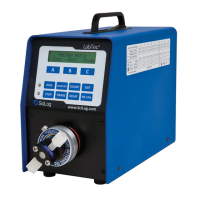37
4
6.4
FMI Pump Heads: Cleaning
Cleaning of Pump Head: Routine flushing with solvent before shutdown will work for most
applications. Set the LabTec™ for maximum pump speed, let the pump run until solvent appears
clear at discharge port. This should be for a minimum of 2 minutes. Do not leave process material
in the pump head overnight. Preventive maintenance is very valuable and ensures a long
operational pump life.
6.6
FMI Pump Heads: Chemical Compatibility
FMI pump heads are well known for their robustness and overall chemical compatibility with
many process fl ids. The materials used in manufacturing FMI pump heads are inert to most
chemicals, however, the following exceptions must be observed:
When pumping: Toluene, Methylethylketone, Acetone, Ethanol, Hexyl Alcohol, Isobutyl Alcohol or
Isopropyl Alcohol, FMI pump heads with Tefzel (ETFE) housings must be used: RH1-CTC;
RHO-CTC; RHOO-CTC. The “T” in CTC designates Tefzel housing.
Tefzel has also excellent chemical resistance to most acids, bases or solvents.
Tefzel pump heads can be used in pump applications not exceeding 90°F and 100 psi (0 - 6.89
bar).
For pump applications involving fl ids above 90°F, FMI pump heads with Kynar (PVDF) housings
must be used: RH1-CKC, RHO-CKC, or RHOO-CKC, the “K” in CKC stands for Kynar.
Kynar has good chemical resistance to most fluids; however, Kynar pump heads must not be used
with Acetone, Ketones or Esters.
6.7
FMI Pump Heads: Viscosity Effects
The LabTec™ FM-200 is capable of pumping high viscosity fl ids. When pumping high viscosity
liquids, you should always use large bore tubing (
1
/ ” OD), slow pump rates and large stroke
volumes (set knurled Adjustment Ring to “400”) in order to avoid pump cavitations.
The LabTec™ FM-200 together with either a RHO or RH1 pump head can handle fluid viscosities
up to 2000 cps, and fluid viscosities up to 5000 cps when the fl id reservoir and feed line
connected to the pump inlet port are pressurized.
Important: Ceramic piston
/
cylinder sets are sensitive to neglect and may “freeze”
if
allowed
to dry out without adequate cleansing. Fill a loop of
fle
xible tubing with
flu
id that
will
thin or
neutralize the last fluid pumped. Then connect one end of the tube to the pump suction port, the
other to the discharge port. With the loop positioned above the pump head, the ceramic surfaces
and seal areas stay moist and mobile for extended idle periods.
However, if a piston freezes in the cylinder,
Do Not Force It Free! Be gentle.
Try to remove the
pump head from the base assembly so the whole pump head can be soaked in a suitable solvent.
If the head is not conveniently removable, the tube loop discussed in the previous paragraph may
permit solvent to dissolve the “frozen” residue in reasonable time.

